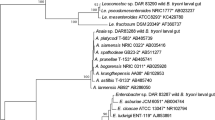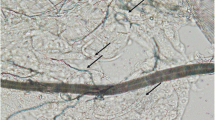Summary
The results of experiments investigating survival of bacteria during the pupal stage gave the following basic findings.
-
(1)
Bacteria are not transmitted in the egg contents, but only on the surface of the eggs.
-
(2)
Artificially cultured pathogenic microorganisms and non-pathogenic strains from a natural environment all survive the pupal stage, whether present individually or mixed. Persistence of the following stock strains was demonstrated:Bacillus anthracis, Salmonella schottmül-leri, Shigella sonnei, Escherichia coli, Bacillus subtilis, Proteus vulgaris, Listeria monocytogenes, Serratia marcescens, Proteus morganii, Salmonella typhimurium andSalmonella typhi. The only one which did not survive was the yeastCryptococcus neoformans. Among bacteria from a natural medium, the following species survived the pupal stage:Proteus vulgaris, bacteria of theProvidentia Group,Escherichia coli, Bacterium paracoli, Staphylococcus aureus, enterococci,Bacillus subtilis andBacillus cereus.
-
(3)
Survival ofSalmonella typhi, contained in excreta on which fly larvae were kept, was not demonstrated. The author regards survival of pathogenic microorganisms under natural conditions as a comparatively rare phenomenon.
Similar content being viewed by others
References
Ark, P. A., Thomas, H. E.:Persistence of Erwinia amylovora in certain insects. Phytopathology 26: 375, 1936.
Bacot, A. V.:The persistence of Bacillus pyocyaneus in pupae and imagines of Musca domestica raised larvae experimentally infected with the Bacillus. Parasitology 4 : 68, 1911.
Cao, G.:Nuove osservazioni sul passagio dei micro-organismi attraverso Vintestino di alcuni insetti. Ann. Igiene Sper. 16: 339, 1906a.
Cao, G.:Sul passagio dei germi attraverso le larve di alcuni insetti. Ann. Igiene Sper. 16: 654, 1906b.
Daniels: Stud. Inst. Med. Res. Malay States 3: 56, 1903.
Dyerbenyeva-Ukhova, V. P.:Flies and their epidemiologica significance. State Med. Pub. House, Moscow, 1952. (Dyerbenyeva-Ukhova, В. П.: Государственн ый Med. Pub. Дом, Москва 1952.)
Faichnie, N.:Fly-borne enteric fever; the source of infection. J. Roy. Army Med. Corps 13: 580, 1909a.
Faichnie, N.:Bacillus typhosus in flies. J. Roy. Army Med. Corps 13: 672, 1909b.
Glaser, R. W.:The survival of bacteria in the pupal and adult stages of flies. Am. J. Hyg. 3: 469, 1923.
Gosio, B.:Über die Verbreitung des Bubonenpesterre-gers durch Insektenlarven. Arch. Schiffs. Trop. Hyg. 29: 134, 1925.
Graham-Smith, G. S.:An investigation of the incidence of the microorganisms known as non-lactose fermenters in flies in normal surroundings and in surroundings associated with epidemic diarrhoea. Ann. Rept. Local Govt. Bd., Supp. Rept. Med. Officer, 41: 304, 1912a.
Graham-Smith, G. S.:An investigation into the possibility of pathogenic microorganisms being taken up by the larva and subsequently distributed by the fly. Ann. Rept. Local Govt. Bd. Supp. Rept. Med. Officer 41: 330, 1912b.
Graham-Smith, G. S.:Flies in relation to disease. Cambridge Univ. Press 292, 1913.
Graham-Smith, G. S.: J. Hyg. (Brit.) 29 (1929). Rep. Soc. Govt. Bd. on Publ. Health and Med. Subj. N. S. 53, 1929.
Gross, H., Preuss, U.:Infektionsversuche an Fliegen mit darmpathogenen Keimen. I. Versuche mit Typhus-Paratyphusbakterien. Zbl. Bakt. I. Abt. 156 : 371, 1951.
Krontowski, A.:Zur Frage über die Typhus-Dysenterieverbreitung durch Fliegen. Zbl. Bakt. I. Abt. 68: 586, 1913.
Kuznetsov, N. J.:Basic insect physiology. Vol. II. Publ. House Acad. Sci. USSR, 1953 (Куз нецов, Н.Дж.: Изд. Дом Ака д. Физ.-мат. CCCP, TOM II. 1953).
Leach, J. G.:Further studies on the seed-corn maggot and bacteria with special reference to potato blackleg. Phytopathology 21: 387, 1931.
Leach, J. G.:The method of survival of bacteria in the puparia of the seed-corn maggot (Hylemyia cilicrura Rond.). Z. angew. Ent. 20: 150, 1933.
Ledingham, J. C. G.:On the survival of specific microorganisms in pupae and imagines of Musca domestica, raised from experimentally infected larvae. Experiments with B. typhosus. J. Hyg. (Cambridge) 11: 333, 1911.
Ledingham, J. C. G.:Dysentery and enteric disease in Mesopotamie from the laboratory standpoint. J. Army med. Corps, London 34: 306, 1920.
Lysenko, O.:Mikroflóra některých našich much. Čs. mikrobiol. 3: 61, 1958.
Málek, I., Wágner, V.:Mikrobiologické vyšetřovaci metody a stručná diagnostika v praxi. Spol. čs. lékařů, Praha 1948.
Muzzarelli, E.: Ann. Igien. 25: 219, 1926.
Nichols, L.:The transmission of pathogenic microorganisms by flies in Saint Lucia. Bull. Entomol. Research 3: 251, 1912.
Ostrolenk, M., Welch, H.:The house-fly as a vector of food-poisoning organisms in food-producing establishments. Am. J. of Publ. Health 32: 487, 1942.
Petragnani, G.: Sperim. Igien. 78: 493, 1925.
Petri2 L.:Richerche sri batteri intestinali delta Mosca olearia. Mem. Staz. Patol. Végétale, Roma, 4: 1, 1909.
Pétri, L.:Untersuchungen über die Darmbakterien der Olivenfliege. Zbl. Bakt. 26: 357, 1910.
Pierce, W. D.:Sanitary entomology. Gorham Press, Boston 1921, p. 518.
Radvan, R.:Přežíváni bakterií při metamorfose Musca domestica L. Sboraík vědeckých prací Voj. lék. akad. JEvP 4: 104, 1956.
Radvan, R.:Přežívání bakterií pŕi vývoji much Musca domestica L. a Protophormia terrae-novae R.-D; Thesis, Czechoslov. Acad. Sci., Prague 1959.
Russo, C.:Recherches expérimentales sur,l’épidémiolo-génése de la peste bubonique par les insectes. Bull. ff. Int. Hyg. Publ. 22: 2108, 1930.
Tebbutt, H.:On the influence of the metamorphosis of Musca domestica upon bacteria administered in the larvae stage. J, Hyg. 12: 616, 1913.
Wollmann, E.:Le rôle des mouches dans le transport de germes pathogènes par la technique des élevages aseptiques. Compt. Rend. Acad. Sci. (Paris) 72(5): 298, 1921.
Author information
Authors and Affiliations
Additional information
The author takes this opportunity of thanking Dr. F. Výmola for identification of the bacteria.
Rights and permissions
About this article
Cite this article
Radvan, R. Persistence of bacteria during development in flies. Folia Microbiol 5, 50–56 (1960). https://doi.org/10.1007/BF02930896
Received:
Issue Date:
DOI: https://doi.org/10.1007/BF02930896




